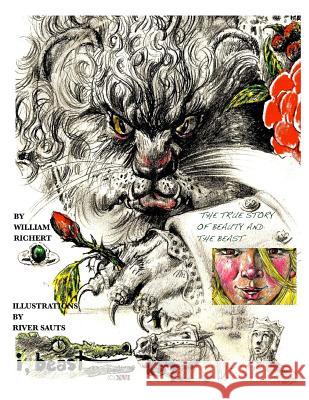I, Beast - The Illustrated Beauty and the Beast: A true Pagan Fairy Tale » książka
I, Beast - The Illustrated Beauty and the Beast: A true Pagan Fairy Tale
ISBN-13: 9781517000813 / Angielski / Miękka / 2015 / 162 str.
FIRST CRITICAL REVIEW: I, Beast - THE ILLUSTRATED BEAUTY AND THE BEAST (156 Pages - 400 Illustrations) By William Richert with River Sauts About the Book: A visual delight A great and brand new read I recently watched the Disney cartoon version of the fairy tale Beauty and the Beast on dvd, along with my young friend Kazia. The movie's Broadway-musical-style show tunes are witty, the Beast is sufficiently ugly and endearing, and Beauty, God bless her, is a rare media heroine who actually reads books Nonetheless, I found myself disturbed by the broad liberties the Disney Studio took in changing classic elements of the tale. William Richert has gone to the source of the tale. The story of Beauty and the Beast as we know it was written by Madame Le Prince de Beaumont (a French woman living in London), published in 1756 in a magazine for "young misses." De Beaumont's tale was based on a 362-page romance published sixteen years earlier by a Parisian artistocrat, Gabrielle Susan Barbot de Gallan de Villeneuve. i BEAST, William Richert's new, illustrated book stays faithful to the original material by de Villeneuve. Unlike de Beaumont's and Disney's simplified abridgement of her story, de Villeneuve's original (written for adult readers in French literary salons) was complex, baroque, and discursive, thickened by many characters and meandering subplots. De Beaumont and Disney also altered Villeneuve's story in a significant way: in their versions, the Beast becomes a sympathetic, even attractive, character before his transformation -- while in the Villeneuve version, as in i BEAST, Beauty requires assurance again and again from a Good Fairy and magical dreams that loving the Beast is a good idea. iBeast (156 Pages - 400 Illustrations) By William Richert with River Sauts About the Book: A visual delight I recently watched the Disney cartoon version of the fairy tale Beauty and the Beast on dvd, along with my young friend Kazia. The movie's Broadway-musical-style show tunes are witty, the Beast is sufficiently ugly and endearing, and Beauty, God bless her, is a rare media heroine who actually reads books Kazia and I both enjoyed it, even if we were laughing at different jokes. Nonetheless, I found myself disturbed by the broad liberties the Disney Studio took in changing classic elements of the tale. The story of Beauty and the Beast as we know it was written by Madame Le Prince de Beaumont (a French woman living in London), published in 1756 in a magazine for "young misses." De Beaumont's tale was based on a 362-page romance published sixteen years earlier by a Parisian artistocrat, Gabrielle Susan Barbot de Gallan de Villeneuve. i BEAST, William Richert's new, illustrated book stays faithful to the original material by de Villeneuve. Unlike de Beaumont's and Disney's simplified abridgement of her story, de Villeneuve's original (written for adult readers in French literary salons) was complex, baroque, and discursive, thickened by many characters and meandering subplots. De Beaumont and Disney also altered Villeneuve's story in a significant way: in their versions, the Beast becomes a sympathetic, even attractive, character before his transformation -- while in the Villeneuve version, as in i BEAST, Beauty requires assurance again and again from a Good Fairy and magical dreams that loving the Beast is a good idea. William Richert's amazing Illustrated version, and his Graphic Novel incarnation, both drawn brilliantly by the incredible artist River Sauts whose work hangs in the Vatican, shall henceforth become the sine qua non of Beauty/Beast literature, illustrated or filmed or written.











